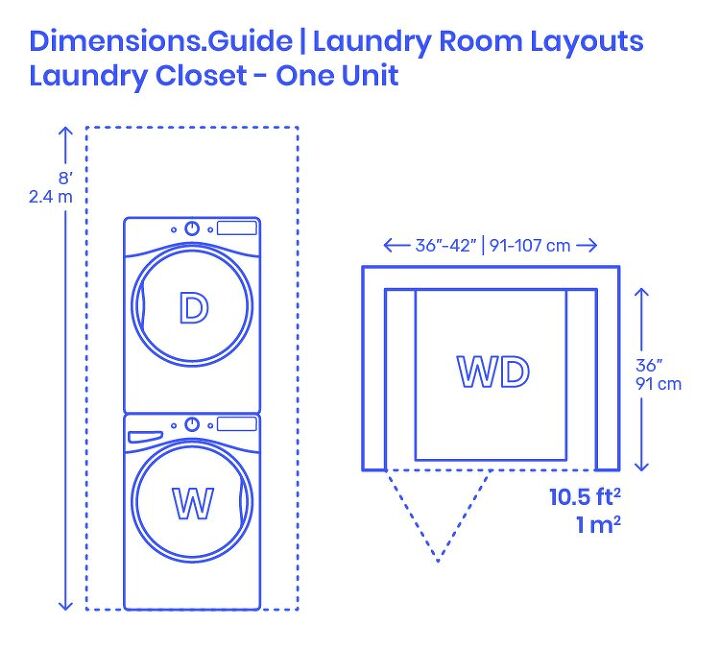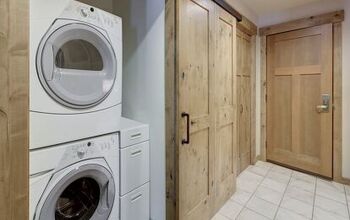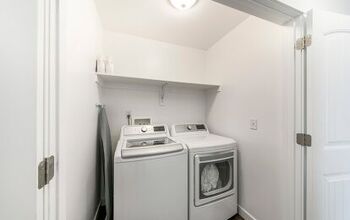Stackable Washer & Dryer Closet Dimensions (with Drawings)

Doing laundry is one of those things most people love to hate. But, having the proper setup for your laundry area can undoubtedly make the chore more tolerable. While having a full laundry room is ideal, you need to get creative if you’re limited on space.
Using a stackable washer and dryer is a great way to fit a laundry area into your home. You can set them up in a small closet, typically at least 36 inches wide by 36 inches deep. Of course, you can play with several configurations based on your available space.
Depending on your layout, you might only have enough space for the machines. But in some cases, an extra foot or so of space can earn you a storage cabinet or shelving. Still, sometimes, you’re lucky if you can simply squeeze the machines into a niche and hide them with a curtain.
Dimensions of a Washing Machine
When determining the space you need for a stackable washer dryer closet, you first need to know the size of your appliances. After all, they’re going to be the main items in the space. If you already have a designated closet for your appliances, then you have to shop around for what will fit.
But what if you are planning out a new closet for your stackable washer and dryer? Then you can perhaps give yourself some extra leeway based on average-sized machines. This way, you can accommodate larger capacity units or additional storage.
The average size of a washing machine is 27 inches wide x 31 inches deep x 39 inches tall. You can find units slightly larger or smaller, but this is the norm when it comes to standard machines.
Dimensions of a Dryer
The typical size of a standard dryer is similar to those of a washing machine. A dryer is approximately 27 inches wide, 26 to 29 inches deep, and between 39 and 42 inches tall. Of course, when you get a stackable system, your units will be the same width and depth.
Video: 6 Tips Before You Buy A Stackable Washer Dryer
Space Needed for a Basic Stackable Washer and Dryer Closet
While the cost and performance of your appliances are paramount, so is their size. You not only need enough room for the actual machines but clearance around them as well. For a stackable washer and dryer, a simple closet does the trick.
If you don’t have an actual closet, you can create a space for your laundry zone. Simply position your machines in a designated area and section them off with a curtain. Many people have even started adding the laundry area into a bathroom.
Basically, if your laundry closet is less than 60 inches wide, then opt for a stacking system. This way, you won’t be cramped when you’re doing laundry. Plus, it provides you more opportunities to work some storage into the space.
After all, storage is pretty necessary for a laundry area. You at least want a place to store a few household essentials, cleaning items, etc. If possible, a little bit of hanging space for clothing is also preferable.
A stackable design averages 27 inches wide, making even a 3-foot closet workable, as long as you have the height.
Overall, you would need roughly 36 to 42 inches of width and 36 inches of depth for a stackable unit. This allows plenty of room for the machines and clearance for things like hoses, cords, and the dryer vent. It also provides you enough space for opening the appliances’ doors.
Stackable Washer and Dryer: Laundry Closet Width
When considering the width of your laundry closet, don’t forget about the doors. Many laundry closets feature a bi-fold door, which means you won’t have the entire doorway opening clear. Therefore, account for the amount of space the doors take up when they are in the open position.
For example, an open bi-fold door consumes roughly five to 6 inches of space. A standard washer or dryer takes up approximately 27 inches of your width. Therefore, a minimum closet width of 33 inches should give you space for your machine and to open appliance doors easily.
However, a couple of extra inches of wiggle room is preferable. So, for more comfort, bump it up to at least 36 inches. You could even fit a slim slide-out set of shelves in this small cranny.
You Can Ditch Laundry Closet Doors
Another option, if your width is limited, is to forgo closet doors altogether. You can either hang a curtain across the opening or leave the machines exposed. On average, this gives you about 5 to 6 more inches of space to play with.
If you have room for a larger width, you can still opt to use a stackable unit. This will enable you to really amp up your available storage space.
Stackable Washer and Dryer: Laundry Closet Depth
The ideal depth for a laundry closet is three feet. In addition to fitting the units, three feet provides ample space for hook-ups, plugs, and the dryer vent.
Standard dryers need an exhaust vent to send heat and moisture outside of the house. The ductwork should be kept to a minimum, as too much can affect your dryer’s performance.
Keep the overall length of your dryer duct run to less than 60 feet. Also, ensure there are minimal turns and bends. Plus, leave between 3 and 5 inches behind your dryer for hook-ups and venting.
Clearance Needed in Front of the Stackable Washer and Dryer Closet
Additionally, stackable washers and dryers are front-load models. Therefore, in addition to the closet space, ensure you leave enough room in front of the closet area to access your machines.
You need enough clearance to open the doors of the machines completely. Plus, you want adequate space to load and unload the machines comfortably.
The door of a dryer or washing machine takes up about 22 to 23 inches when open. In addition to this space, you also want to account for any additional space you need to maneuver around. You cannot reverse front load washer doors.
Stackable Washer and Dryer: Laundry Closet Height
If your ceilings are a standard 8 feet high, you’ll have no problem fitting a stackable unit in the closet. Typically, stackable units reach about 75 to 80 inches tall. Some appliances feature stacking kits that come with a built-in pull-out shelf.
This shelf is excellent for adding some extra workspace for folding clothes; then, you can hide it away. But it will add slightly to the overall height of the units.
If you have taller ceilings, you could hang some shelving for additional storage above the units. Make sure to stick to these washer and dryer closet dimensions.
What If You Don’t Have Room for a Stackable Unit?
If you’re really tight on space, even if using a stackable system, consider compact appliances.
Compact washers and dryers are smaller than standard laundry appliances. They range from between 24 and 27 inches wide and are about 34 inches high.
On average, these compact machines are about 23 inches deep, and the dryers are typically only available in electric models. However, these compact models are available as stackable systems, so it’s a solid option for you.
For example, the Equator stackable set is only 59 inches tall, 23.5 inches wide, and 22 inches deep. So you can maximize your space, but keep in mind you’ll need to do more loads of laundry.
Smaller appliances mean extra cycles to accommodate the same amount of loads a standard washer and dryer can handle. However, a small washer and dryer are better than making a bunch of trips to the laundromat.
Related Questions
Can you use a pedestal under a stackable washer and dryer?
While pedestals beneath washers and dryers can be handy for extra storage, they are a no-go with stackables. Pedestals cannot support the weight of stackable units. Therefore, you’ll need to look elsewhere for storage options.If you have room to spare, add shelving. Or, you can get a rolling cart that you can move into position as needed or store elsewhere.
Can you stack any front-load washer and dryer?
While it might be tempting to purchase some budget appliances and simply stack them; it’s not that simple. Front-load washing machines and dryers usually come with stacking kits that install between the two units. This kit ensures the machines stack safely on top of each other. You generally cannot stack different brands of machines on each other.It’s not recommended to stack units without a stacking kit. The best course of action is to purchase a stacking kit when you get your appliances. Stacking kits typically cost anywhere from $35 to $100 or more, depending on your machines.Make sure to purchase a kit that is specifically made for your model of washer and dryer.
How much do stackable washers and dryers cost?
Of course, price varies broadly based on brand, quality, capacity, energy efficiency, and more. However, new stackable washers and dryers typically cost between $1,025 and $2,500. Electric models are usually slightly less, but the difference is negligible. These costs are for the units themselves. If you have to pay for installation, hook-ups, etc., the prices will go up significantly. New hook-ups can be anywhere from $700 to over $2,000. This range depends on how far your laundry area is from existing water lines, venting, and gas lines, where applicable.

Stacy Randall is a wife, mother, and freelance writer from NOLA that has always had a love for DIY projects, home organization, and making spaces beautiful. Together with her husband, she has been spending the last several years lovingly renovating her grandparent's former home, making it their own and learning a lot about life along the way.
More by Stacy Randall


















![10 Best Cordless Leaf Blowers – [2022 Reviews & Ultimate Guide]](https://cdn-fastly.upgradedhome.com/media/2023/07/31/9070789/10-best-cordless-leaf-blowers-2022-reviews-ultimate-guide.jpg?size=350x220)
![10 Best Scroll Saws for 2022 [Ultimate Reviews & Buyer's Guide]](https://cdn-fastly.upgradedhome.com/media/2023/07/31/9070684/10-best-scroll-saws-for-2022-ultimate-reviews-buyer-s-guide.jpg?size=350x220)












